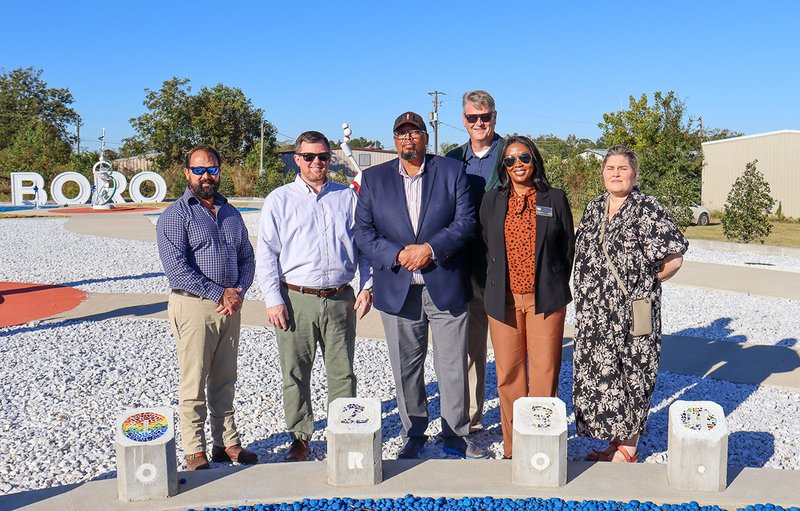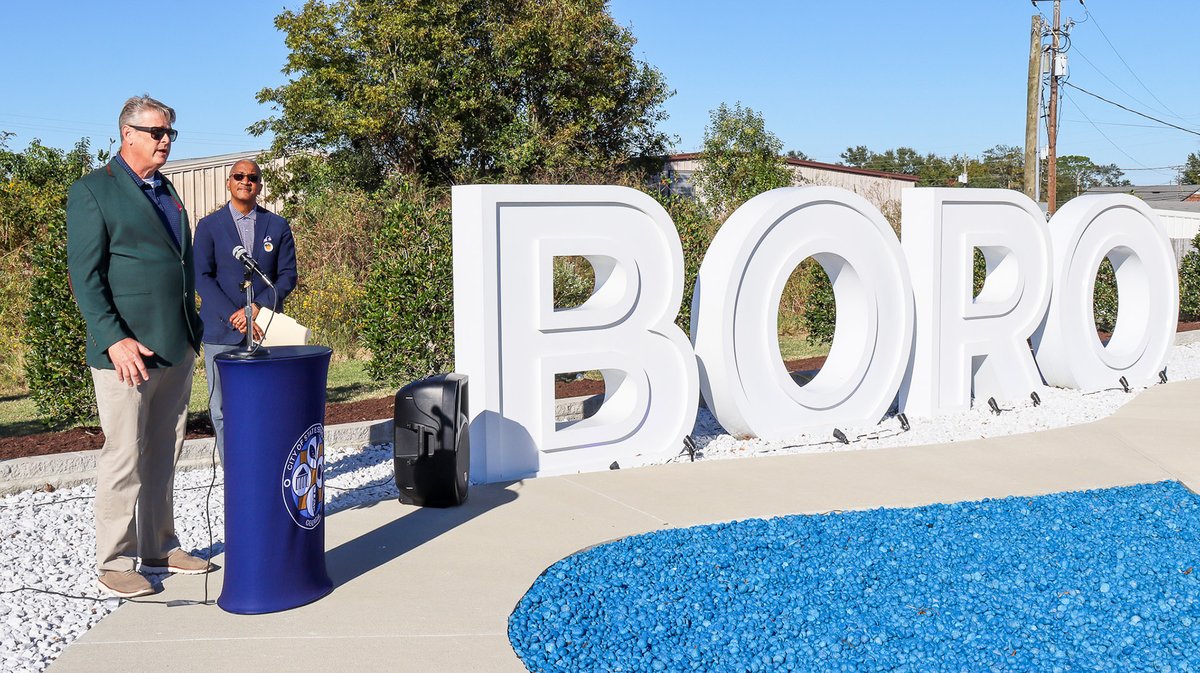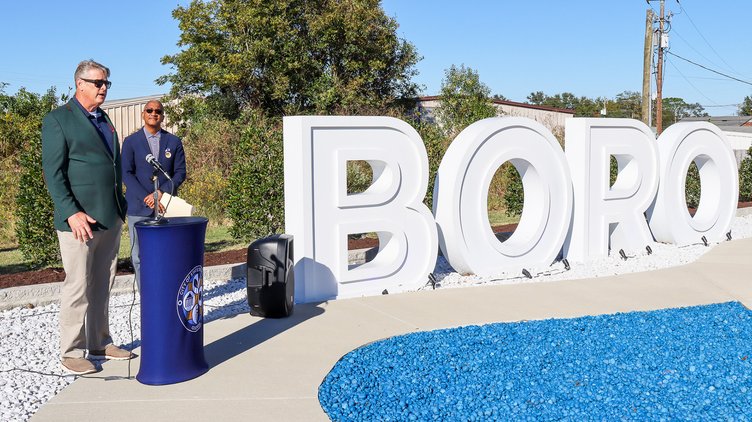After taking shape nearly two years ago as a flower when seen from overhead, the Statesboro Art Park recently blossomed with four potentially removable abstract sculptures, becoming a “permanently temporary” attraction, in the words of former City Councilman Phil Boyum.
Boyum, who represented District 1 on the council for about 12 years, shepherded the art park’s design and creation as a city project. Now spending most of his time in Florida where his parents live in retirement, he resigned from the council effective Aug. 1 but was back in the Boro for a ribbon cutting ceremony at the art park the afternoon of Oct. 17.
“Imagine a museum without any of the artwork,” he recapped in a later interview. “You walk in and there’s nothing on the floor, nothing on the walls. Everything’s white. When you take out the sculptures, we have a nice blank palette downtown that fortunately because it’s just like an outdoor museum we’ll be able to change over time.”
Visible from the Willie McTell Trail east of City Hall, the park occupies a strip of land leased by the city from the Norfolk Southern Railway, beside its tracks at the corner of East Main and Railroad Streets. Nearly a decade ago, the Downtown Statesboro Development Authority, or DSDA, first expressed interest in the site for a park. It was then included in lease arrangements for the larger area a little farther south along the tracks and trail that became the dog park in 2018. The city pays about $300 a year for the smaller site.
Before the cleanup and construction began, the lot held things such as crossties left on the ground there by the railway company, and trash had accumulated. But Norfolk Southern placed conditions on the property’s use, when leased to the city, for safety purposes and so the land can be reclaimed for use by the railroad in the future if needed.
“Ultimately, if there’s one thing I want to get across from folks, it’s that really we designed the art park for the location,” Boyum said. “It’s not like we wanted to put an art park in and we just decided to put it there. That piece of property has so many limitations, the biggest of it being ‘no permanent installations,’ so that means no water, no buildings, no facilities – you know, you can’t put a bathroom there. It all has to be able to be removed by the railroad or by the city.”
With those limitations, Boyum and other supporters of the project decided, “We could still make it look nice,” and provide another venue for art in downtown Statesboro, he said.
The moderately curvy walkway into the park forms a branching stem. Three side blossoms and a larger flower at the “top,” farthest north, contain pads for the art installations.
“It has petals. It has a curvilinear stem. Some of the features associated with it are various colors of rock, a natural color of concrete,” as Assistant City Manager Jason Boyles described in a January 2023 presentation. “The elements along the flower are varied in colors and textures, creating some contrast.”
By that point those surface aspects of the park, installed by the city’s Public Works Department, were mostly in place. Now, 22 months later, all of the spaces for art installations are filled.
Four current sculptures
The current featured attractions are four sculptures created by artists with national reputations. The following descriptive quotes were provided by Layne Phillips, public affairs manager for Statesboro’s city government.
“Lemongrass” by Gregory Johnson. “A visually captivating and emotionally resonant sculpture that merges form, motion, material, and light. Inspired by the artist’s life journey and nature’s curves, the artist created lyrical shapes that evoke familiar yet intangible feelings, challenging minds and boundaries.”
“Underfire” by Adam C. Walls. “The sculpture is derived from the artist's love of fantasy, escapism, and pop-culture imagery.”
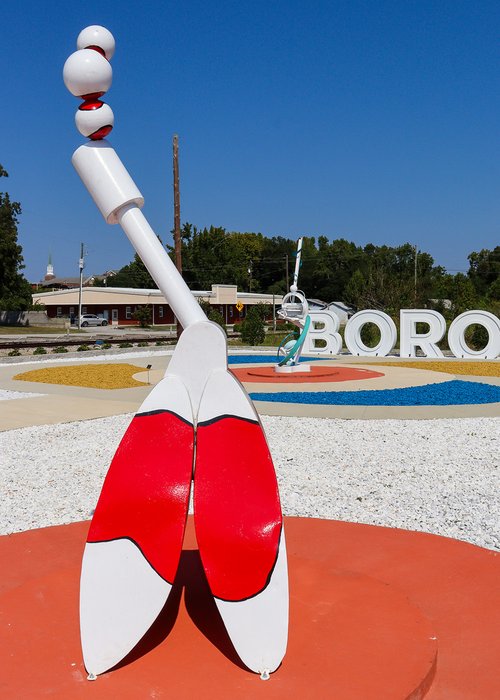
“Meditation Bench” by Glenn Zweygardt “explores the theme of finding one’s place in a relationship with nature, which allows the artist to share his collective experiences with others.”
“Slider” by Duke Oursler. “The sculpture was designed to embody balance, weight, and gravity, symbolizing harmony.”
To aid in the selection of the sculptures, the city formed an Art Advisory Committee consisting of five members: Kim Riner, Michael Van Wagenen, Marc Moulton, Frank D’Arcangelo and Johnesia Lucas.
“Since the City of Statesboro desired to have art installed as soon as possible, the committee reached out to artists who had completed pieces in inventory that could be delivered quickly,” Phillips reported.
“Through the work of this committee, one-year lease agreements were signed for three of the pieces, which span from July 2024 to July 2025,” she wrote. “One piece, ‘Meditation Bench,’ was purchased by the city as a permanent fixture in the park.”
But “permanent” is a relative term, according to Boyum, with even that piece remaining potentially moveable from the leased space.
Incidentally, “Meditation Bench” is more for meditating upon than sitting on, being a vertical structure. More than one local observer has noted a passing resemblance to a guillotine, but it may also evoke a torii, or Japanese temple gate.
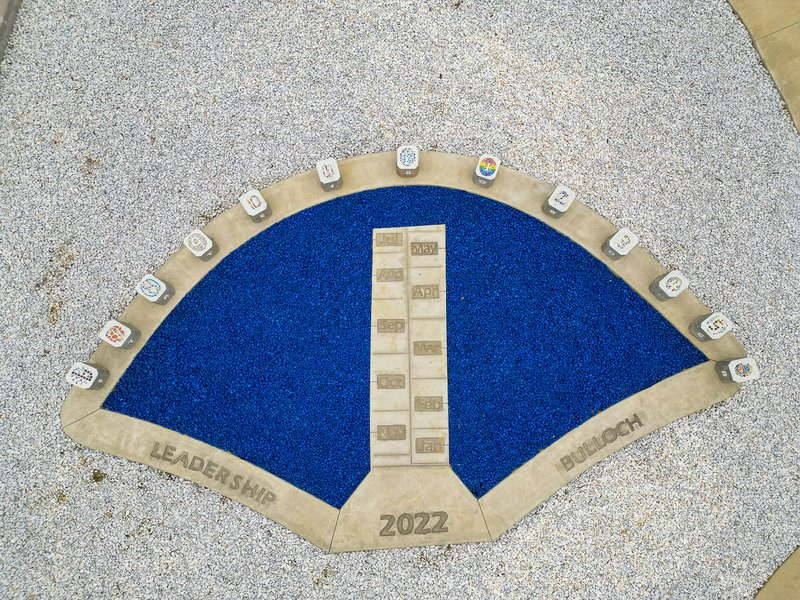
Future competitions
For the future, the city and its Art Advisory Committee plan to issue a public call for sculpture design submissions at least once every two years. A juried competition would result in placement of newly completed sculptures.
Two other relatively permanent structures help complete the park. The “analemmatic sundial,” uses the sun and shadows to display time, but a person visiting the structure must serve as his or her own gnomon, or pointer, standing in the correct place for the month and approximate date to cast a shadow on the hour markers.
The sundial was donated by the Leadership Bulloch Class of 2022.
Then there’s the “BORO” sculptural aluminum lettering at the back of the park, as originally proposed by the DSDA. Graphic vinyl wraps can be applied to the bare aluminum for seasonal or special events, Boyum said.
‘Rocks’ and plants
Multicolored “rocks” filling in spaces in and around the giant flower that outlines the park are aggregate plastic and glass material created by Jon Cook of GreenRock Recycling, the local company previously known as Boro Recycling. Mayor Pro Tem Shari Barr, the District 5 councilmember and an advocate of “greener” practices, praised this aspect of the park.
No actual trees or plants are growing in the rectangular expanse that includes the walk and art installations. But trees have been planted outside the rectangle on the side opposite from the railroad track, and shrubs have been planted on the side toward the railroad. About 80 plants in all were placed around the park, by Boyum’s count.
Art Park’s cost
Remarking that construction can be done “fast, cheap or with quality” but not all three, Boyum said the Art Park is a quality project developed slowly but frugally by having the city’s public works employees do most of the work.
The Statesboro city government and the DSDA, together, spent roughly $108,578 on the park materials, art purchase and art leases and some paid installation work, according to a list that Olympia Gaines, assistant to the city manager, provided. She gathered the numbers from other staff members after the Herald requested a total.
Of that total, more than half, $55,380, was spent for the “BORO” lettering, supported though a Tax Allocation District agreement with the DSDA.
Direct city costs included $10,426.55 for concrete, $3765 for concrete block, $1,200 for recycled “rock,” $4,104 for white stone, $4,575 for trees and landscaping materials, $5,996.91 for other materials, and $3,130 for miscellaneous expenses including bronze plaques, mounting and installation.
The city also paid $5,000 to purchase the Meditation Bench sculpture and a total of $15,000 for the three one-year art lease agreements.
The Public Works Department also spent over 1,200 employee hours in development of the site, Gaines reported, but this was not assigned a dollar value by the city.
Currently the starting pay for city groundskeepers is about $15 an hour, and if those involved averaged $16.67 for 1,200 hours, that would add $20,000, so $130,000 may be a reasonable total cost estimate for the project.
